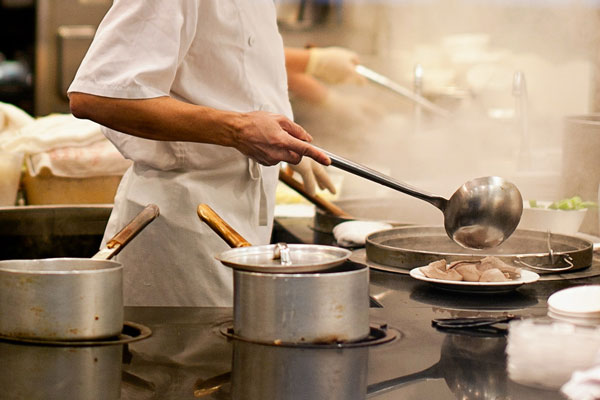Using Artificial Intelligence to Strengthen your Food Safety Program
In many facets of our lives today, we see technology driving innovation and changes that 25 years ago were unimaginable. Though, for many of the front lines of foodservice operations across the county, technological changes are often slow to impact the day-to-day operations of foodservice businesses. Often, this is because technology can be quite expensive to implement, and that expense doesn’t even consider the time it takes to train staff on the new pieces of technology.
One of the most recent advances is artificial intelligence, or AI. In the world of higher education, AI is impacting a lot of what we do. It may be more abstract for the frontline foodservice manager who could not see AI “doing their job”. However, I do believe it will have, or could positively impact all of our jobs – even for our frontline employees and managers in the food and beverage industry. Thus, I thought I might highlight some of the ways AI could be used to improve food safety in your operation.
AI programs, such as the OpenAI ChatGPT platform, allow a user to go in and ask random questions, request certain information, and even develop plans for food safety. For example, if you forgot what the endpoint cooking temperature for pork is, you can ask it and it will give you the temperature to which you should cook whole cuts (such as pork chops, pork roasts, and pork loins) and ground pork. For the different products I tested in the system, it was accurate for all that I explored.
While artificial intelligence is revolutionizing the way food safety and our environment operates, you do need to be careful…review the data it provides to ensure it is accurate.
For another example, I asked it to provide me with a 10-minute pre-shift meeting on handwashing. Below is the outline it provided:
Pre-Shift Training on Handwashing – 10 Minute Outline
-
-
-
- Introduction (2 minutes)
-
-
-
-
-
-
- Welcome and greet the team.
- Highlight the importance of handwashing in food safety.
- Emphasize the role of each team member in maintaining a safe food environment.
-
-
-
-
-
-
- The Significance of Handwashing (2 minutes)
-
-
-
-
-
-
- Discuss the potential risks of improper hand hygiene, such as foodborne illnesses and customer health.
- Explain the impact on the restaurant’s reputation and compliance with regulations.
-
-
-
III. When to Wash Hands (1 minute)
-
-
-
- Highlight key times when handwashing is mandatory:
- Before starting work
- After using the restroom
- After handling raw food
- After touching body, face, or clothing
- After sneezing, coughing, or using a tissue
- Highlight key times when handwashing is mandatory:
-
-
-
-
-
- Proper Handwashing Procedure (3 minutes)
-
-
-
-
-
-
- Detail the steps:
- Wet hands with warm, running water.
- Apply soap and lather thoroughly.
- Scrub hands for at least 20 seconds.
- Focus on palms, back of hands, fingernails, between fingers, and wrists.
- Rinse hands thoroughly.
- Dry hands with disposable towels or air dryer.
-
-
-
-
-
-
- Glove Usage (1 minute)
-
-
-
-
-
-
- Discuss the importance of handwashing even when gloves are worn.
- Explain that gloves are not a substitute for handwashing.
-
-
-
-
-
-
- Maintaining Personal Hygiene (1 minute)
-
-
-
-
-
-
- Encourage team members to keep fingernails short and clean.
- Remind them to avoid wearing jewelry that can trap food particles.
-
-
-
VII. Reporting Illness (30 seconds)
-
-
-
-
- Stress the responsibility of reporting any illness symptoms, especially gastrointestinal issues, to the management.
- Mention the importance of not handling food when unwell.
-
-
-
VIII. Monitoring and Enforcement (30 seconds)
-
-
-
-
- Discuss the role of supervisors and management in monitoring handwashing practices.
- Mention the consequences for non-compliance and the need for corrective actions.
-
-
-
-
-
-
- Q&A and Clarifications (1 minute)
-
-
-
-
-
-
- Open the floor for questions, comments, or concerns.
- Clarify any points or provide additional information as needed.
-
-
-
-
-
-
- Conclusion and Recap (30 seconds)
-
-
-
-
-
-
- Summarize the key takeaways from the training.
- Reiterate the importance of handwashing for food safety and customer well-being.
-
-
-
-
-
-
- Demonstration (1 minute) – Optional
-
-
-
-
-
-
- Conduct a live demonstration of the proper handwashing procedure.
- Invite team members to participate or ask questions during the demonstration.
-
-
-
XII. Handout Distribution (1 minute) – Optional
-
-
-
-
- Provide handouts summarizing the handwashing procedure and key points for reference.
-
-
-
XIII. Acknowledgment and Commitment (1 minute) – Optional
-
-
-
-
- Request team members to acknowledge their commitment to following proper handwashing practices.
- Encourage them to take personal responsibility for maintaining a safe food environment.
-
-
-
XIV. Closing (30 seconds)
-
-
-
-
- Thank the team for their participation and attention.
- Remind them that hand hygiene is a collective effort in ensuring food safety.
- Ensure that this 10-minute pre-shift training is engaging, informative, and tailored to your specific foodservice operation’s needs and procedures.
-
-
-
So, all in all, it was pretty accurate. It does lack some specificity, for example, points on why handwashing is so very important. But considering it took all but 30 seconds to get that training plan, for a busy foodservice manager, AI could become an invaluable tool and give you something upon which to build. Give it a try, you might be surprised at what you are able to do with it.
While artificial intelligence is revolutionizing the way food safety and our environment operates, you do need to be careful. Always carefully review the data it provides. As an example, t does tend to switch between temperatures intended for consumer and home cooking with the temperatures mandated in the food code. For this reason, I almost always add “based on the 2022 model food code” to my requests to make sure I am getting something related to commercial applications.
There are many ways this technology is impacting our environment. This is just one way that you could use it directly to benefit you and your business. As technology continues to advance, the integration of AI into foodservice operations will become increasingly essential for both the well-being of customers and the success of businesses in the food industry. Risk Nothing. Using Artificial Intelligence to Strengthen your Food Safety Program
READ MORE POSTS
The Human Factor and Food Safety
A few weeks ago, we discussed the top five causes of foodborne illness, 1) Improper hot/cold holding temperatures of time and temperature control for safety foods; 2) Improper cooking temperatures of food; 3) Dirty and/or contaminated utensils and equipment; 4) Poor employee health and hygiene; and 5) Food from unsafe sources. As I noted, all of these items are not in the direct control of your staff, but most can be. For the second blog this month, I wanted to discuss a bit more about the human factor in our food safety programs.
What is the Greatest Threat to Food Safety?
What is the Greatest Threat to Food Safety?
Food Safety Considerations for the “New Way” of Dining, Part II – Back-of-house
In our first blog this month, we discussed the importance of front-of-house practices as we emerge from the pandemic this summer and into fall. Making your guests feel safe will be an important point as we welcome them back to our establishment. The safer they feel, the more likely they are to revisit and this could, in turn, be a competitive advantage for your business.
Food Safety Considerations for the “New Way” of Dining
Spring is my favorite time of year, as we head out of the winter months, welcome warmer weather, and increase the daylight hours. As such, we turnover a new leaf and welcome new life as our grass, trees, and perennials come out of dormancy. This year as the Coronavirus vaccine continues its roll out and we welcome a third vaccine onto the market this morning, perhaps this spring we are turning over a ‘new leaf’ in a much more profound way, as we see light at the end of the Coronavirus tunnel.










